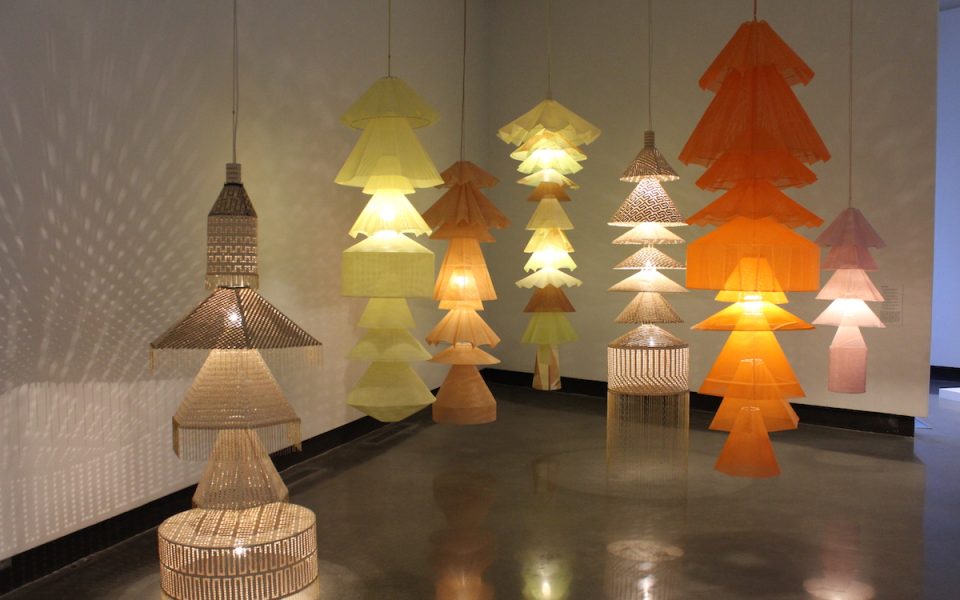You don’t really think about it.
You use it to sit, to eat, to sleep. But most of us don’t give a second thought to the furniture we use on a day-to-day basis. Now, an exhibit at the Southeastern Center for Contemporary Art in Winston-Salem encourages visitors to reconsider furniture as art.
Furnished, which opened in mid July, runs until Jan. 5 and includes more than 50 works by 15 contemporary artists from North Carolina, South Carolina, Tennessee and Virginia.
“So I moved to North Carolina and I’m like, ‘What’s with all this furniture here?’ I didn’t know,” says Wendy Earle, the curator of contemporary art for SECCA. “I’ve never lived in a place that had a furniture industry. It’s just like one of those things, like it comes from IKEA like everything else…. They make a lot of it here and they sell a lot of it here, so what’s that all about? I started looking into the history of it and I started thinking, What does that mean for contemporary art?”
Earle says Furnished is the first SECCA show focused exclusively on furniture.
At the bottom of the stairs in SECCA’s main gallery space, twisting curls carved from wood suspend a lone bench in the middle of the gallery floor. The solid plank, sculpted to look like driftwood, invites weary passengers to take respite.

“Bench for the Platform at Fashoda Junction” by South African artist Graham Campbell imagines the bench as an artifact from a parallel past. As explained on the piece’s description, the work represents a bench that could have existed at the proposed Fashoda Junction, a stop on a railway project started by European forces in the 1880s that would have connected Cape Town, South Africa and Cairo. After a war between competing European countries, the railway never took complete shape.
“I imagine that the Shilluks, who had always lived there, might have cheekily built a bench like this,” states Campbell in the description. “It would be pleasant to sit on and watch the boats sail up and down the Nile as they had for thousands of years.”
Like Campbell’s piece, much of the exhibition uses furniture in innovative ways to shed light on complex histories or share unique ideas.
“It’s sort of showing you that the world of furniture, there’s a lot more there,” says Earle. “It’s not just like look at this great designed chair, we can think about a lot of different issues within the realm of furniture.”
Nearby, Jose Pablo Barreda’s wall sculptures showcase the artist’s creative ability to take old pieces of furniture and deconstruct them to create new works of art.
The head of an alligator juts out from the seat of a chair, his snout protruding into space, his teeth individually carved, peeking out from his mouth. The gentle curve of what perhaps used to be the arm or leg of the chair now creates the bottom jawline of the beast. A slight smile emerges. His neighbor, a stern bull, boasts equally intriguing features, with the back arch of a chair now used to represent the bull’s horns.
-

Jose Pablo Barreda deconstructs old furniture to create new art. (photo by Sayaka Matsuoka) -

Barreda’s alligator shows off his toothy grin. (photo by Sayaka Matsuoka)
“I think it’s important to understand the creativity of people working outside of what you would think of as the traditional art field,” Earle says. “Even for a functional chair, it’s about craftsmanship, it’s about design, it’s about a real understanding of the issues they’re trying to address… these are people who aren’t usually in art museums but absolutely deserve to be.”
While the entire show is focused on furniture, some of the pieces, like Barreda’s, could be categorized more as sculpture, while others remain functional.

Annie Evelyn’s three pieces in the show blend high fashion and ornamental design with functionality. Using a thick foam covered by intricately painted tile or pristine jewelry, Evelyn piques viewers’ interest by toeing the line between art and craft. Visitors can sit on her pieces, but from afar they look untouchable.
-

Annie Evelyn’s cathedral train chair acts as a chair you can wear. (photo by Sayaka Matsuoka) -

Annie Evelyn’s “Nest” combines foam, wood, leather and painted jewelry pieces to create a unique sculptural piece.
Because of the interactive nature of the show, Earle encourages visitors to attend one of the guided tours so they can touch and sit on the works.
Still, other pieces don’t require participation to experience at all.
Charlotte artist Austin Ballard’s “Light Forest” (featured image) as Earle calls it, hangs in a corner of the gallery, gently illuminating the space. Upside-down cones formed from needlepoint sheets stack on top of one another, creating long, dangling columns that hang from the ceiling. Visitors can walk in and out of the suspended lamps, each in different shades of pastel or neon. Alone, the pieces could fit in a modern home above a dining table but clustered together, the columns create a more immersive experience.
“You know, we don’t all have sculptures in our house, we don’t all have paintings or photographs, but we all have furniture,” Earle says. “We all have that initial understanding of like…‘I know what furniture is.’ Let’s see where else it can go.”
Join the First Amendment Society, a membership that goes directly to funding TCB‘s newsroom.
We believe that reporting can save the world.
The TCB First Amendment Society recognizes the vital role of a free, unfettered press with a bundling of local experiences designed to build community, and unique engagements with our newsroom that will help you understand, and shape, local journalism’s critical role in uplifting the people in our cities.
All revenue goes directly into the newsroom as reporters’ salaries and freelance commissions.


Leave a Reply